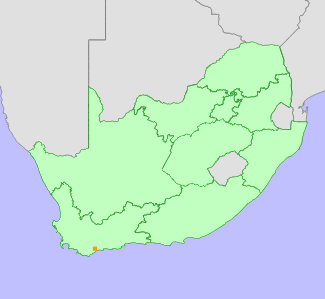|
Scientific Name | Lachenalia barbarae G.D.Duncan |
Higher Classification | Monocotyledons |
Family | HYACINTHACEAE |
National Status |
Status and Criteria | Critically Endangered B1ab(iii)+2ab(iii); C2a(i,ii); D |
Assessment Date | 2022/08/22 |
Assessor(s) | G.D. Duncan, H. Mtshali & O.E. Curtis |
Justification | A Western Cape endemic that has an extent of occurrence (EOO) and an area of occupancy (AOO) of 4 km², and is known from one location. Fewer than 50 mature individuals are known, and the population is inferred to be declining due to ongoing habitat degradation. It is therefore listed as Critically Endangered under criteria B, C, and D. |
Distribution |
Endemism | South African endemic |
Provincial distribution | Western Cape |
Range | This species has a restricted distribution in the Overberg region of the Western Cape Province, South Africa, where it occurs within the Haarwegskloof Renosterveld Reserve. |
Habitat and Ecology |
Major system | Terrestrial |
Major habitats | Eastern Ruens Shale Renosterveld |
Description | This geophyte is found on northwest facing slopes between quartz pebbles, stones, and rocks at 245 m.a.s.l. |
Threats |
| The only known subpopulation has recently been protected; however, this species has already lost the majority of its Renosterveld habitat to crop cultivation, and only small remnants of its former habitat remain. It is not known if this species requires fire for persistence, but given the fragmented nature of Overberg Renosterveld, it is likely that disruption of habitat connectivity and natural fire return intervals could be causing habitat degradation and population decline. |
Population |
The only known subpopulation is highly localised, and plants occur as scattered individuals or in small groups of up to six individuals. Fewer than 50 mature individuals are known. The population trend is unknown, but a continuing decline is inferred based on severe habitat loss and fragmentation due to wheat cultivation in the past and the fact that ecological processes, including fire, have been disrupted.
|
Population trend | Decreasing |
Bibliography |
D.G., D. 2017. Two new species, two rediscoveries and a range extension in Lachenalia (Asparagaceae: Scilloideae) from southern and western South Africa. Phytotaxa 316(3):261-270.
|
Citation |
| Duncan, G.D., Mtshali, H. & Curtis, O.E. 2022. Lachenalia barbarae G.D.Duncan. National Assessment: Red List of South African Plants version 2024.1. Accessed on 2025/11/11 |
 Comment on this assessment
Comment on this assessment

